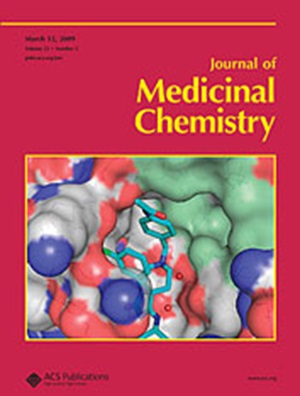Design, Synthesis, and Evaluation of a Novel Positron Emission Tomography Tracer Targeting Fibroblast Activation Protein: From Bench to Bedside
IF 6.8
1区 医学
Q1 CHEMISTRY, MEDICINAL
引用次数: 0
Abstract
FAPI-PET/CT has become a promising tool for cancer diagnosis. However, the pharmacokinetic properties of FAPI tracers need optimization. Here, we developed a novel FAPI tracer, [18F]AlF-NOTA-SP2A-FAPT, for cancer imaging. NOTA-SP2A-FAPT was successfully synthesized and radiolabeled with a high radiochemical purity. [18F]AlF-NOTA-SP2A-FAPT displayed satisfying stability, hydrophilicity, and affinity to FAP, as well as specific uptake in A549-FAP cells. Micro-PET/CT showed that [18F]AlF-NOTA-SP2A-FAPT is rapidly excreted through the renal system. [18F]AlF-NOTA-SP2A-FAPT exhibited high tumor uptake and excellent retention, showing better tumor delineation compared to [18F]FDG and [18F]AlF-NOTA-FAPI-42. Pilot clinical studies of [18F]AlF-NOTA-SP2A-FAPT and head-to-head comparison with [18F]FDG were performed on 13 cancer patients. Compared to [18F]FDG, [18F]AlF-NOTA-SP2A-FAPT had higher uptake in primary tumor and lymph node metastases as well as favorable distribution and good tumor retention. In conclusion, [18F]AlF-NOTA-SP2A-FAPT demonstrated high tumor accumulation, as well as improved pharmacokinetic properties. [18F]AlF-NOTA-SP2A-FAPT could emerge as a promising alternative to the currently established FAPI tracers.

针对成纤维细胞活化蛋白的新型正电子发射断层扫描示踪剂的设计、合成和评价:从实验室到床边
FAPI-PET/CT已成为一种很有前途的癌症诊断工具。然而,FAPI示踪剂的药动学特性有待优化。在这里,我们开发了一种新的FAPI示踪剂[18F]AlF-NOTA-SP2A-FAPT,用于癌症成像。成功合成了NOTA-SP2A-FAPT,并以高放射化学纯度进行了放射性标记。[18F]AlF-NOTA-SP2A-FAPT在A549-FAP细胞中表现出令人满意的稳定性、亲水性和对FAP的亲和力,并具有特异性摄取。Micro-PET/CT显示[18F]AlF-NOTA-SP2A-FAPT通过肾脏系统快速排泄。与[18F]FDG和[18F]AlF-NOTA-FAPI-42相比,[18F]AlF-NOTA-SP2A-FAPT表现出高的肿瘤摄取和良好的保留,显示出更好的肿瘤描绘。对13例肿瘤患者进行了[18F]AlF-NOTA-SP2A-FAPT的初步临床研究,并与[18F]FDG进行了正面比较。与[18F]FDG相比,[18F]AlF-NOTA-SP2A-FAPT在原发肿瘤和淋巴结转移中摄取更高,且分布良好,肿瘤保留良好。综上所述,[18F]AlF-NOTA-SP2A-FAPT具有较高的肿瘤蓄积性,并且改善了药代动力学特性。[18F]AlF-NOTA-SP2A-FAPT可能成为目前建立的FAPI示踪剂的有希望的替代品。
本文章由计算机程序翻译,如有差异,请以英文原文为准。
求助全文
约1分钟内获得全文
求助全文
来源期刊

Journal of Medicinal Chemistry
医学-医药化学
CiteScore
4.00
自引率
11.00%
发文量
804
审稿时长
1.9 months
期刊介绍:
The Journal of Medicinal Chemistry is a prestigious biweekly peer-reviewed publication that focuses on the multifaceted field of medicinal chemistry. Since its inception in 1959 as the Journal of Medicinal and Pharmaceutical Chemistry, it has evolved to become a cornerstone in the dissemination of research findings related to the design, synthesis, and development of therapeutic agents.
The Journal of Medicinal Chemistry is recognized for its significant impact in the scientific community, as evidenced by its 2022 impact factor of 7.3. This metric reflects the journal's influence and the importance of its content in shaping the future of drug discovery and development. The journal serves as a vital resource for chemists, pharmacologists, and other researchers interested in the molecular mechanisms of drug action and the optimization of therapeutic compounds.
 求助内容:
求助内容: 应助结果提醒方式:
应助结果提醒方式:


